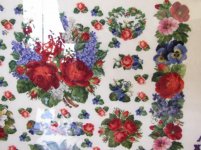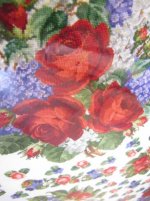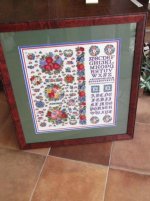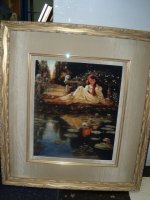Did hear.....
Mikki, Did you what is being used in PPFA comp. this year? You do great work! Darth
The 2013-2014 official PRINT is a needlework creation by textile artist Nhia Lo. With this Hmong PaNdau needlework, each piece is an exquisite, original hand-made creation. On a background fabric approximately 6 ½” square, the image is 4” x 4”. The hand-made appliqué and reverse-appliqué quilt block features hand-dyed Batik fabric over magenta or rose-colored accent fabric on a tan background. There are tiny, hand-embroidered stitches, and all fabrics are 100% cotton. The design is a traditional Hmong design, but this particular color combination will be exclusive to PPFA.BACKGROUND — HMONG: The Hmong are an Asian ethnic group from the mountainous regions of China, Vietnam, Laos, and Thailand. In 1975 tens of thousands fled to Thailand from Laos seeking political asylum. Thousands of these refugees have resettled in Western countries since the late 1970s, mostly the United States, but also in Australia, France, Canada, South America and in smaller numbers elsewhere around the world. Many Hmong refugees resettled in the United States after the Vietnam War.Hmong groups are often named after the dominant colors, patterns of their traditional clothing, head-dress, and the provinces from which they came. Flower Hmong or the Variegated Hmong (Hmong Lenh or Hmong Hoa) are so named because of the bright colorful embroidery (called pa ndau, literally “flower cloth”).
BACKGROUND – PA NDAU: When the Hmong first arrived in the United States in the late 1970s, some of the families were initially resettled in Pennsylvania. While residing there, Hmong women learned appliqué techniques from the Amish community. Hmong embroidery and appliqué / pa ndau feature various traditional motifs chosen for their meaning, and the blocks are known as story cloths.
Traditionally, Hmong embroidery includes bright colors and is used as a form of decoration on clothing to make it bright and beautiful. From a young age, Hmong girls learn how to sew and copy motifs from their mothers and grandmothers.
Hmong women adapted traditional motifs and developed new styles and crafts for commercial purposes, especially targeted to tourists and the Western market. From traditional textile decorations on clothes, they developed tapestry or story cloths. These tapestries first appeared in the 1980’s when the Hmong people lived in refugee camps. Since there was little opportunity to make money, the women used their embroidery skills to earn income to support their families.
The traditional story cloth squares were adapted to larger sizes, and these oversize squares were transformed into table cloths, pillows, and wall decorations. They also inspired household and accessory items, and blocks are now often sold at local art festivals and craft shows.
BACKGROUND – ARTIST: Textile artist Nhia Lo was born in Naam Lao, Laos. She came to the United States in 1975 and currently resides in Morganton, NC, just on the outskirts of Asheville in the mountains of the western part of the state.
Nhia can usually be found manning her booth at many, various quilt shows around the country, including the annual Quilt Odyssey in Hershey, Pennsylvania, where PPFA members first spotted Nhia and her work. The tables in her booth are piled with hundreds of her gorgeous creations, and she always has a needle in her hand, working on another block. Many blocks are sold individually, while others are sewn into bags / totes, clothing, or other finished items. Always friendly, Nhia eagerly shares her passion for her craft with anyone admiring her artistry.
HANDLING CHALLENGE: This fabric needleart will test the competitor’s knowledge of proper textile handling and mounting techniques. Should it be laced and over-matted? Floated? Presented straight or “on-point” in quilter’s style? Competitors are urged to consult the publication “PPFA Guidelines for Framing Textiles and Needlework” for information on the appropriate handling of this piece. The book is available from the PPFA bookstore and provides valuable information on preservation materials and mounting methods for all types of textiles .
--------------------------------------------------------------------------------









